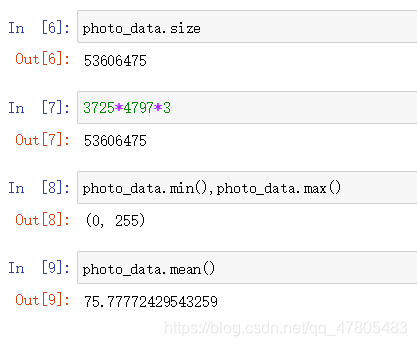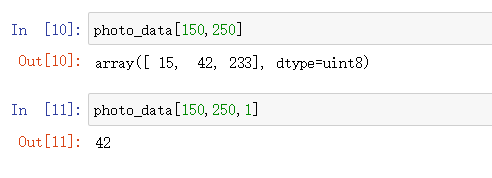Data Processing and Visulisation with Python
Satellite Image Data Analysis using numpy and matplotlib
Loading the libraries we need: numpy, matplotlib
import numpy as np
import matplotlib.pyplot as plt
Creating a numpy array from an image file
Lets choose a satellite image file as an ndarray and display its type
photo_data = plt.imread('sd-3layers.jpg')
type(photo_data)

Let’s see what is in this image
plt.figure(figsize=(10,10))
plt.imshow(photo_data)

photo_data.shape

The shape of the ndarray show that it is a three layered matrix. The first two numbers here are length and width, and the third number (i.e. 3) is for three layers: Red, Green and Blue.
RGB Color Mapping in the Photo:
RED pixel indicates Altitude
BLUE pixel indicates Aspect
GREEN pixel indicates Slope
The higher values denote higher altitude, aspect and slope. 
photo_data.size
3725*4797*3
photo_data.min(),photo_data.max()
photo_data.mean()

Pixel on the 150th Row and 250th Column
photo_data[150,250]
photo_data[150,250,1]

Set a Pixel to All Zeros
We can set all three layer in a pixel as once by assigning zero globally to that (row,column) pairing. However, setting one pixel to zero is not noticeable.
photo_revise = photo_data.copy()
photo_revise[150,250] = 0
fig,ax = plt.subplots(1,2,figsize=(20,10))
ax[0].imshow(photo_data),ax[1].imshow(photo_revise)

photo_revise = photo_data.copy()
photo_revise[150,250] = 0
photo_revise[200:800,:,:] = 255
fig,ax = plt.subplots(1,2,figsize=(20,10))
ax[0].imshow(photo_data),ax[1].imshow(photo_revise)

photo_revise = photo_data.copy()
photo_revise[150,250] = 0
photo_revise[200:800,:,:] = 0
fig,ax = plt.subplots(1,2,figsize=(20,10))
ax[0].imshow(photo_data),ax[1].imshow(photo_revise)

Changing Colors in a Range
We can also use a range to change the pixel values. As an example, let’s set the green layer for rows 200 to 800 to full intensity.
# set all three layers to full intensity
# set all three layers to 0
Pick all Pixels with Low Values
low_filter = photo_data<100
low_filter.shape,photo_data.shape

Filtering Out Low Values
Whenever the low_value_filter is True, set value to 0.
photo_revise = photo_data.copy()
low_filter = photo_data<200
photo_revise[low_filter]=0
fig,ax = plt.subplots(1,2,figsize=(20,10))
ax[0].imshow(photo_data),ax[1].imshow(photo_revise)

More Row and Column Operations
You can design complex pattens by making cols a function of rows or vice-versa. Here we try a linear relationship between rows and columns.
photo_revise = photo_data.copy()
length = len(photo_revise)
length
photo_revise[:length,:length]=0
fig,ax = plt.subplots(1,2,figsize=(20,10))
ax[0].imshow(photo_data),ax[1].imshow(photo_revise)

Masking Images
Now let us try something even cooler…a mask that is in shape of a circular disc.

photo_revise = photo_data.copy()
p_row,p_col,p_layer = photo_revise.shape
X,Y = np.ogrid[:p_row,:p_col]
X
Y
photo_revise.shape
c_row = p_row/2
c_col = p_col/2
dist_c = (X-c_row)**2 + (Y-c_col)**2
r = (p_row/2)**2
mask = dist_c > r
print(mask[1200:1300,1200:1300])
photo_revise[mask] = 0
fig,ax = plt.subplots(1,2,figsize=(20,10))
ax[0].imshow(photo_data),ax[1].imshow(photo_revise)

Further Masking
You can further improve the mask. For example, just get the upper half of the disc.
upper_half = X < c_row
mix_mask = upper_half | mask
photo_revise = photo_data.copy()
photo_revise[mix_mask] = 0
fig,ax = plt.subplots(1,2,figsize=(20,10))
ax[0].imshow(photo_data),ax[1].imshow(photo_revise)

Further Processing of our Satellite Imagery
Processing of RED Pixels
Remember that red pixels tell us about the height. Let us try to highlight all the high altitude areas. We will do this by detecting high intensity RED Pixels and muting down other areas.
photo_revise = photo_data.copy()
mask = photo_revise[:,:,0] < 150
photo_revise[mask] = 0
fig,ax = plt.subplots(1,2,figsize=(20,10))
ax[0].imshow(photo_data),ax[1].imshow(photo_revise)

photo_revise = photo_data.copy()
mask = photo_revise[:,:,1] < 150
photo_revise[mask] = 0
fig,ax = plt.subplots(1,2,figsize=(20,10))
ax[0].imshow(photo_data),ax[1].imshow(photo_revise)

Detecting Highly-GREEN Pixels
photo_revise = photo_data.copy()
mask = photo_revise[:,:,2] < 150
photo_revise[mask] = 0
fig,ax = plt.subplots(1,2,figsize=(20,10))
ax[0].imshow(photo_data),ax[1].imshow(photo_revise)

Composite mask that takes thresholds on all three layers: RED, GREEN, BLUE
photo_revise = photo_data.copy()
r_mask = photo_revise[:,:,0] < 150
g_mask = photo_revise[:,:,1] > 50
b_mask = photo_revise[:,:,2] < 100
photo_revise[r_mask|g_mask|b_mask] = 0
fig,ax = plt.subplots(1,2,figsize=(20,10))
ax[0].imshow(photo_data),ax[1].imshow(photo_revise)

photo_revise = photo_data.copy()
r_mask = photo_revise[:,:,0] < 150
g_mask = photo_revise[:,:,1] > 50
b_mask = photo_revise[:,:,2] < 100
photo_revise[r_mask&g_mask&b_mask] = 0
fig,ax = plt.subplots(1,2,figsize=(20,10))
ax[0].imshow(photo_data),ax[1].imshow(photo_revise)






















 1万+
1万+











 被折叠的 条评论
为什么被折叠?
被折叠的 条评论
为什么被折叠?








